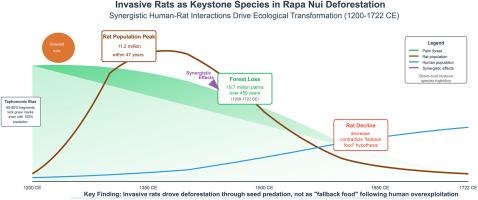重新评估波利尼西亚鼠(Rattus exulans)在拉帕努伊(复活节岛)森林砍伐中的作用:区系证据和生态模型
IF 2.5
1区 地球科学
Q1 ANTHROPOLOGY
引用次数: 0
摘要
引进的波利尼西亚鼠(Rattus exulans)在拉帕努伊森林砍伐中的作用仍然是一个有争议的问题。包括Mieth和Bork(2010)在内的一些批评者认为,与人类的影响相比,老鼠的作用可以忽略不计。我们通过三条证据线来解决老鼠的作用:(1)对老鼠是可以忽略不计的论点的回应,包括有问题的大陆类比和对种子捕食影响的误解;(2)对阿纳基纳(Anakena)挖掘的大鼠遗骸(1986-2005)的分析表明,随着时间的推移,老鼠的数量会减少,这与它们在资源枯竭后作为“后备食物”的说法相矛盾;(3)生态模型表明,引入的大鼠在47年内可以达到1120万只,95%的种子捕食足以阻止棕榈再生。我们的综合证据表明,老鼠是一种重要的入侵物种,通过与人类森林砍伐的协同作用,推动了人类历史上最完整的生态转变之一。这些发现挑战了简单的人为“生态灭绝”的叙述,并强调了入侵物种在岛屿环境变化中的关键作用。本文章由计算机程序翻译,如有差异,请以英文原文为准。

Reassessing the role of Polynesian rats (Rattus exulans) in Rapa Nui (Easter Island) deforestation: Faunal evidence and ecological modeling
The role of introduced Polynesian rats (Rattus exulans) in the deforestation of Rapa Nui remains a contentious issue. Several critics, including Mieth and Bork (2010), argue that rats played a negligible role compared to human impacts. We address the role of rats through three lines of evidence: (1) a response to rats-are-negligible arguments, including problematic continental analogies and misunderstandings of seed predation impacts; (2) analysis of rat remains from Anakena excavations (1986–2005) showing that rats decreased over time, contradicting claims they served as a “fallback food” following resource depletion; and (3) ecological modeling demonstrating that introduced rats could reach populations of 11.2 million within 47 years, with 95 % seed predation sufficient to prevent palm regeneration. Our integrated evidence supports rats as a keystone invasive species that, through synergistic interactions with human forest clearing, drove one of the most complete ecological transformations documented in human history. These findings challenge narratives of simple anthropogenic “ecocide” and highlight the critical role of invasive species in island environmental change.
求助全文
通过发布文献求助,成功后即可免费获取论文全文。
去求助
来源期刊

Journal of Archaeological Science
地学-地球科学综合
CiteScore
6.10
自引率
7.10%
发文量
112
审稿时长
49 days
期刊介绍:
The Journal of Archaeological Science is aimed at archaeologists and scientists with particular interests in advancing the development and application of scientific techniques and methodologies to all areas of archaeology. This established monthly journal publishes focus articles, original research papers and major review articles, of wide archaeological significance. The journal provides an international forum for archaeologists and scientists from widely different scientific backgrounds who share a common interest in developing and applying scientific methods to inform major debates through improving the quality and reliability of scientific information derived from archaeological research.
 求助内容:
求助内容: 应助结果提醒方式:
应助结果提醒方式:


